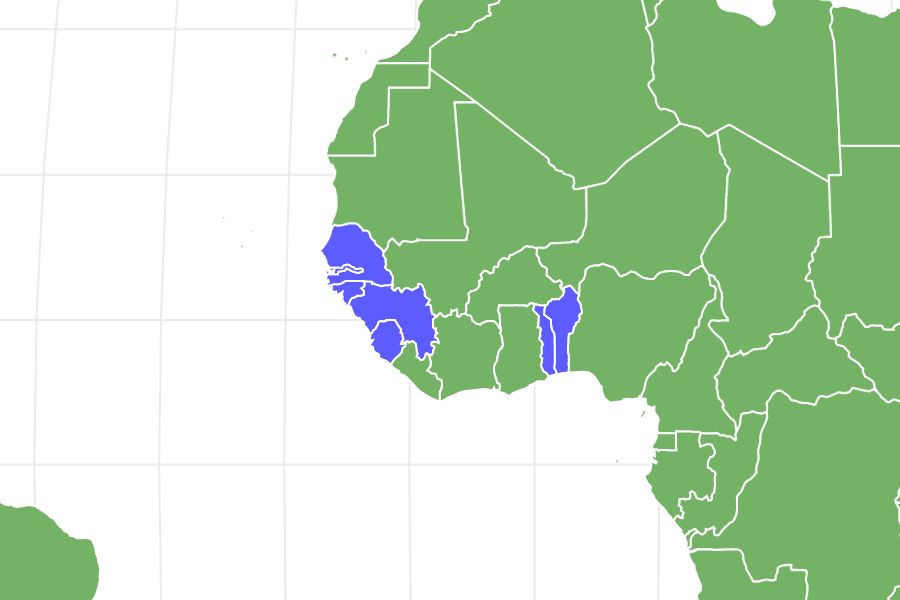Western Green Mamba
Dendroaspis viridis
Advertisement
Western Green Mamba Scientific Classification
- Kingdom
- Animalia
- Phylum
- Chordata
- Class
- Reptilia
- Order
- Squamata
- Family
- Elapidae
- Genus
- Dendroaspis
- Scientific Name
- Dendroaspis viridis
Read our Complete Guide to Classification of Animals.
Western Green Mamba Conservation Status
Western Green Mamba Facts
- Diet
- Carnivore
- Common Name
- Green mamba
Western Green Mamba Physical Characteristics
- Color
- Yellow
- Black
- Green
- Orange
- Lifespan
- 5-18 years
- Length
- 4.6-8 feet
- Venomous
- Yes
- Aggression
- Low
View all of the Western Green Mamba images!
Western green mambas can reach a length of up to eight feet.
A collection of bright green scales is just one of the many notable things about this snake. It can also travel through its tropical forest or savanna habitat at an average speed of 7 miles per hour! The western green mamba consumes a diet of birds, squirrels, and mice. It has potent venom with the potential to cause death.
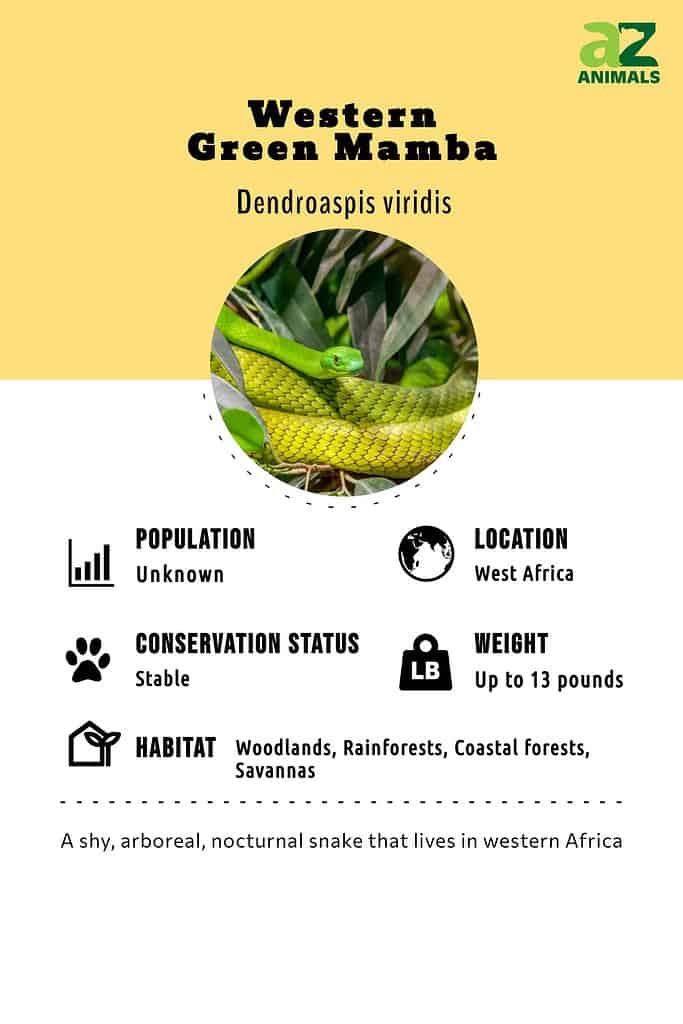
4 Amazing Facts
- These snakes sleep on tree branches surrounded by leaf cover
- The symptoms of this snake’s venom begin to occur within 15 minutes of the bite
- Newly hatched snakelets can be as long as 17 inches
- They have impressive speed both in trees and on the ground
Where to Find Them
This snake lives in the western part of Africa. It’s found in the countries of Benin, Gambia, Guinea, Guinea-Bissau, Senegal, Sierra Leone, and Togo.
They live in a tropical savanna, mangrove, rainforest, or tropical dry forest habitat. While they spend most of their time in the trees, they are also found on the ground hunting, looking for water, or searching for mates. They are active and most visible during the daylight hours.
Types of Mambas

Jameson’s Mamba is a close relative of the Western Green Mamba.
©Vladislav T. Jirousek/Shutterstock.com
There are a total of four species of mamba snake. They are members of the Elapidae family.
- Eastern green mamba (Dendroaspis angusticeps)-The eastern green mamba has bright green scales just like its western counterpart and is very similar in size. A big difference is that the eastern green mamba lives in the eastern part of Africa.
- Black mamba (Dendroaspis polylepis)-Though western green mambas and black mambas are both African snakes, there are several differences between them. Contrary to its name, the black mamba isn’t always black. It can be brownish or gray in color. Also, at up to 14 feet plus, the black mamba is larger in size than the western green mamba.
- Jameson’s mamba (Dendroaspis jamesoni)-Jameson’s mamba and the western green species are approximately the same size and have green scales. A difference between these snakes is the female Jameson’s mamba usually has a larger number of eggs.
Scientific Name
Dendroaspis viridis is the scientific name of a western green mamba snake. The Latin word Dendroaspis means tree asp and the word Viridis means green. It’s part of the Elapidae family and the class Reptilia.
Population and Conservation Status
The population information on the IUCN Red List of Threatened Species doesn’t include a specific number, but the western green mamba is of Least Concern. It’s thought of as common in many areas, and its population is stable.
Appearance and Description
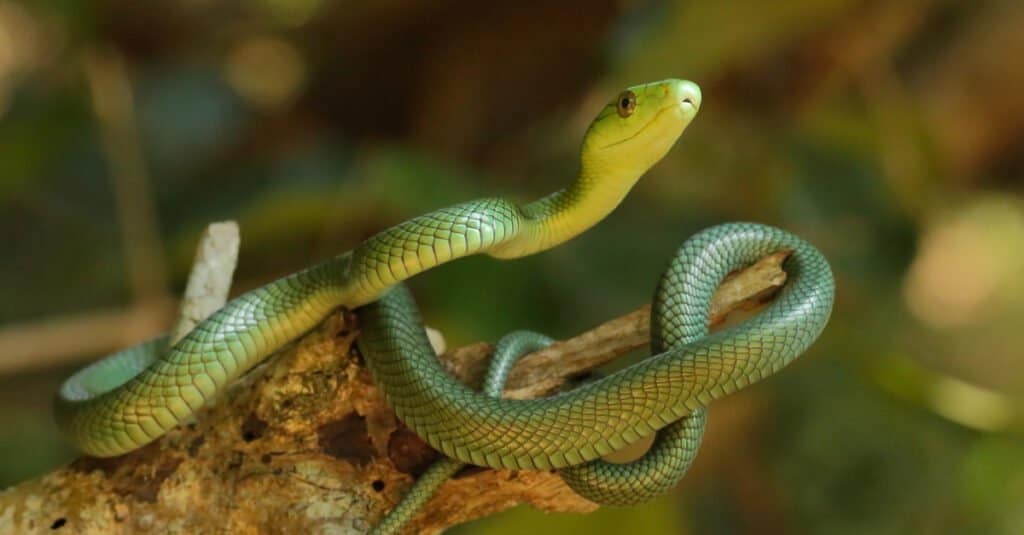
Juveniles are blue-green, becoming bright green when they are around 2 ft 6 in long.
©NickEvansKZN/Shutterstock.com
The western green mamba has bright green scales on its back that fade to yellow near its tail. It has yellow scales on its belly. Each of its green scales has a black edge making its pattern even more distinct.
The color of a juvenile’s scales is blue/green until the snake reaches a size of 30 inches. From there, the snake starts to take on the bright green scales of an adult.
This African snake has a long slender body measuring from 4.6 up to 8 feet. Its color and slender structure allow this snake to blend very well into its habitat in the trees. It curls around the branches and adeptly moves through the different levels of a tree. Sometimes this snake remains in the same tree for several days.
Their round eyes have yellowish-brown irises.
How to identify a western green mamba:
- Bright green scales that fade to yellow toward its tapered tail
- Its scales have black edges making the pattern stand out
- It has yellow scales on its underside
- A slender, long body perfect for grasping tree branches
- Round eyes with a yellow-brown iris
Habitat
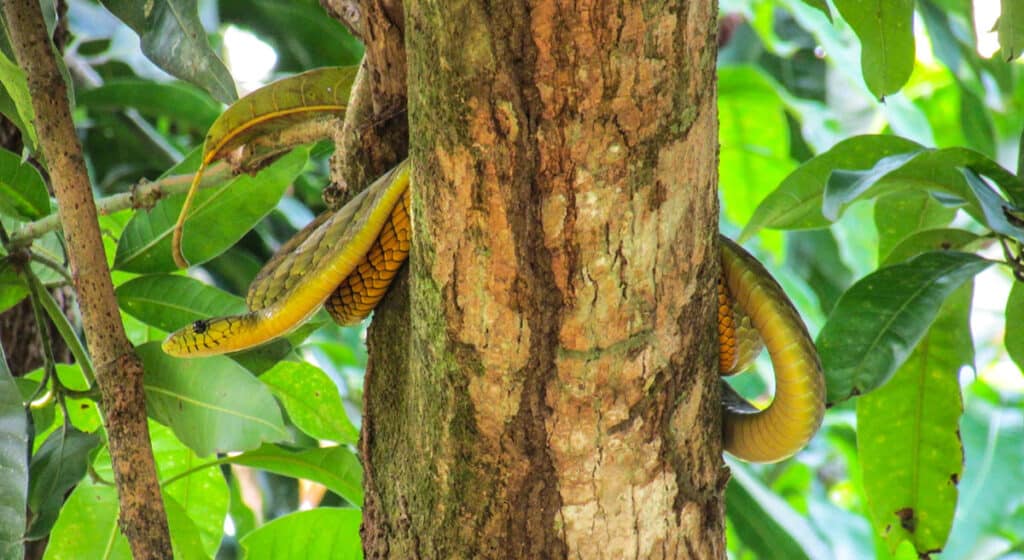
Western green mambas (D. viridis) often rest in trees, waiting for prey to wander too close.
©© yakoo1986, some rights reserved (CC-BY-NC) – License
The Western Green Mamba snake is found in much of western Africa, from Senegal to Chad and Cameroon. They prefer habitats with plenty of cover, such as dense forests, savannas, and woodlands. They are most often seen near water or around rocky hillsides, where they can hide among vegetation or rocks. During the day, they usually stay within 25 feet above ground levels and are known to climb up trees and other structures if needed.
At night they may venture further away from their daytime resting spots in search of food, such as rodents, birds, bats, and lizards which they swallow whole after killing them with their powerful venom. They are also able to cross short distances between branches by stretching out their bodies while maintaining balance using the prehensile tail that curves upwards at the end like a hook allowing them to grip objects firmly.
Diet
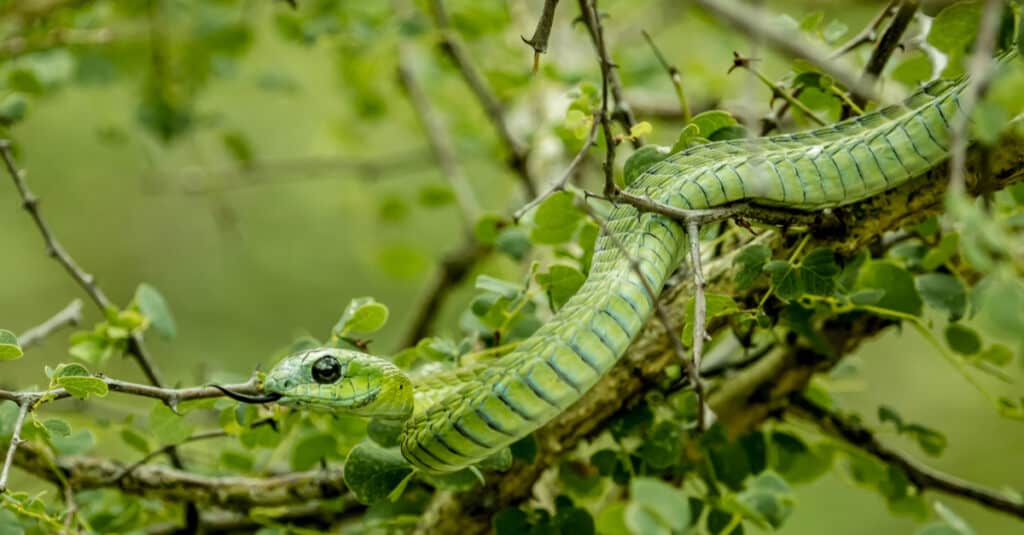
Western green mambas eat lizards and birds out of trees.
©OrodO/Shutterstock.com
Because they are arboreal snakes, they feed primarily on small birds and lizards like geckos. They hunt by using their keen sense of smell to detect prey, as well as their sharp vision in order to spot potential food sources before striking out with lightning speed. Their diet also consists of invertebrates such as spiders, scorpions, centipedes, frogs, and other amphibians. When hunting for larger prey items such as rodents or birds, they will use ambush tactics that involve waiting patiently until the target enters into range before quickly lunging forward and seizing it with their powerful jaws. In addition to these tactics, they may also occasionally scavenge corpses of animals that have already died due to natural causes or have been killed by other predators in the area.
Reproduction and Life Cycle
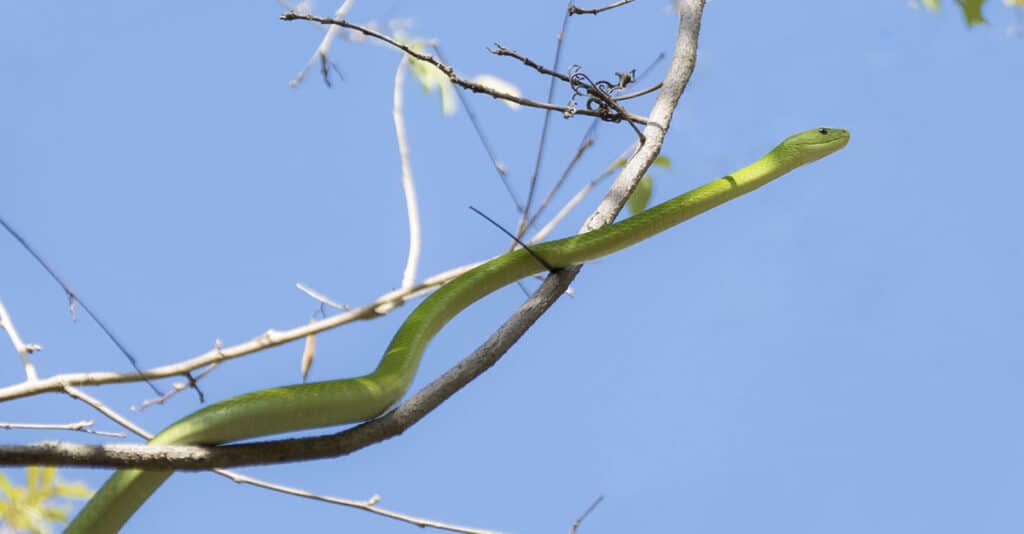
Western green mambas lay 6-15 eggs per clutch.
©Ewout Knoester, some rights reserved (CC-BY-NC) – License
Western Green Mamba snakes reproduce through oviparity, meaning they lay eggs. They typically produce a clutch of 6-15 eggs in the late spring or early summer. The female will select a warm, dark location, such as under rocks or logs, to lay her eggs and provide protection from predators. After about two months, the young hatchlings emerge from their shells and are independent immediately after birth.
The Western Green Mamba reaches maturity at 2-3 years old and can live for up to 10 years in captivity if cared for properly. In the wild, however, these snakes usually only reach an age of 5 due to predation by larger animals like birds or mammals as well as humans hunting them for their skin which is highly desired for leather goods production.
Western Green Mamba Pictures

Western green mambas (D. viridis) inhabit coastal rainforests in West Africa.
©Sibons photography/Shutterstock.com
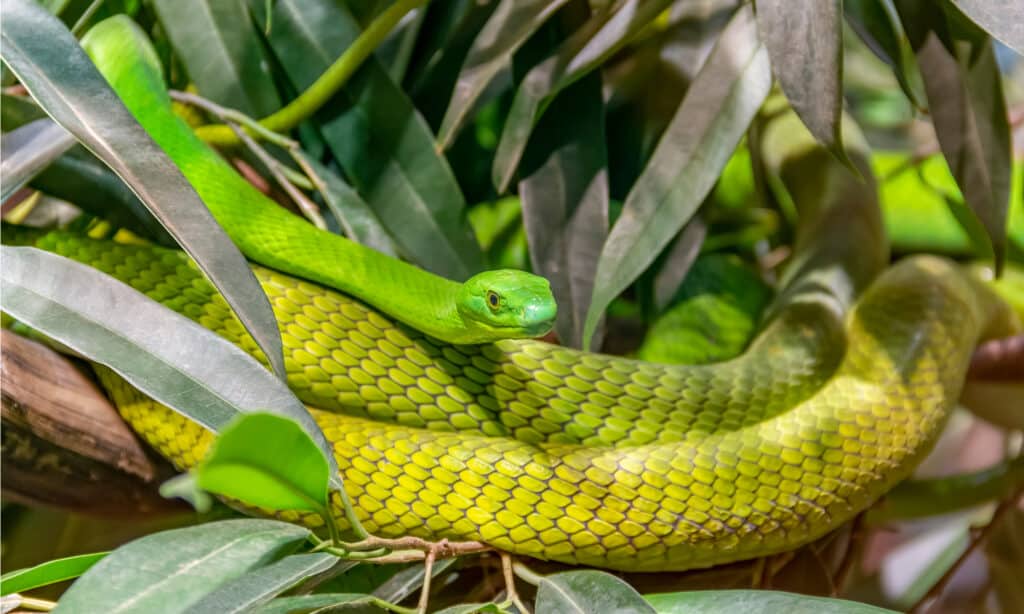
Western green mambas enjoy hiding away in trees, out of sight from humans.
©PRILL/Shutterstock.com

These snakes can measure up to 8 feet long.
©Eric Isselee/Shutterstock.com
Venom: How Dangerous Are They?
These snakes are dangerous with a potent, fast-acting venom. In fact, the venom begins to cause symptoms in someone who is bitten within about 15 minutes. The fast-acting nature of its venom has resulted in several fatalities.
But, keep in mind, they spend most of their lives high up in the trees. So, humans usually don’t see them, much less get bitten by one. Also, this species is considered a shy snake. You may have heard myths about the aggression of mamba snakes. There is even a myth that the black mamba will chase a human in an effort to give them a venomous bite! But factual information about this reptile shows the western green and the other species of mambas are most likely to try to escape when threatened.
The first step to take if bitten is to get to a hospital for antivenom. The bite wound should be snugly wrapped along with the upper part of the person’s affected arm or leg. Keeping the wounded limb as still as possible is an essential part of care in this situation.
Behavior and Humans

A Green mamba prefers to live a solitary and nocturnal life.
©iStock.com/Simoneemanphotography
Western Green Mamba snakes are solitary and nocturnal, preferring to rest in tree hollows during the day. They become active at night, searching for prey such as small rodents, birds, lizards, and frogs. These snakes can be very aggressive if threatened and will use their venomous bite as a defensive mechanism. When in danger, they may coil up into a tight spiral with their heads raised off the ground to strike from a distance.
Western Green Mambas have excellent vision, which helps them locate potential prey even in dim light conditions. They also possess an acute sense of smell that allows them to track down food sources over long distances. In terms of communication, they rely on chemical signals released by body secretions or through vibrations produced by rubbing against objects such as branches or rocks. The Western Green Mamba is not known to actively seek out human interaction but will attack when provoked or disturbed in its natural habitat.
View all 108 animals that start with WWestern Green Mamba FAQs (Frequently Asked Questions)
Are western green mambas venomous?
Yes, one of the first pieces of information to learn about this snake is it strikes quickly with fast-acting, strong venom.
How do western green mambas hunt?
Western green mambas are active during the day and have superb vision. They combine their excellent vision, sense of smell and great speed to search for prey. When they locate prey, these mambas strike several times very quickly injecting venom into the animal. The rodent or bird dies quickly from the venom allowing the snake to swallow it.
Are western green mambas aggressive?
No. Western green mambas are not aggressive.
Where do western green mambas live?
This snake is native to the western portion of Africa. Specifically, it lives in Benin, Gambia, Guinea, Guinea-Bissau, Senegal, Sierra Leone, and Togo.
Western green mambas are found in a tropical climate. They are seen in savannas, rainforests, and mangroves as well as in a dry forest habitat. They are called arboreal snakes because they live most of their lives in trees.
What do western green mambas eat?
The diet of this snake features squirrels, rodents, and birds.
How venomous is the western green mamba?
Its powerful venom has caused human fatalities and kills their prey very quickly. Antivenom is an essential part of care for a bite wound.
What are the 4 types of mamba?
The group of four includes the eastern green mamba, the western green mamba, the black mamba, and the Jameson’s mamba.
What is the difference between the eastern green mamba and the western green mamba?
Well, the most fundamental difference between these two snakes is the western green mamba lives in the western part of Africa while the eastern green mamba lives in the eastern portion of Africa. Their general habitat is the same, but eastern green mambas live in citrus, mango, and other fruit trees and are sometimes seen on plantations as a result.
The diet of these two snakes is a little different as well. While the western green mamba snake has a diet of squirrels, rodents, and birds the eastern green mamba eats those animals as well as bats.
In relation to diet, the method of hunting can differ between these two snakes. The eastern green mamba has been known to sit and wait in the branches of a tree near a bat cave. When a bat, or group of bats flies out, the snake uses its speed and accurate movements to capture its meal.
While the venom of both the western and the eastern green mamba is potent, the venom of the eastern green mamba is considered the less toxic of the two. But remember a bite from either snake needs immediate care in the form of antivenom from a hospital.
Thank you for reading! Have some feedback for us? Contact the AZ Animals editorial team.
Sources
- African Snakebite Institute, Available here: https://www.africansnakebiteinstitute.com/snake/african-snakes-western-green-mamba/
- Wikipedia, Available here: https://en.wikipedia.org/wiki/Western_green_mamba
- IUCN, Available here: https://www.iucnredlist.org/species/13265799/13265808
- Safaris Africana, Available here: https://safarisafricana.com/animals/green-mamba/
- UCSD, Available here: http://toxicology.ucsd.edu/Snakebite%20Protocols/Dendroa4.htm
- Reptile Database, Available here: http://reptile-database.reptarium.cz/species?genus=Dendroaspis&species=viridis&search_param=%28%28search%3D%27western+green+mamba%27%29%29
- African Snakebite Institute, Available here: https://www.africansnakebiteinstitute.com/snake/african-snakes-eastern-green-mamba/

